#which makes it all the more funnier considering my...standard equipment
Explore tagged Tumblr posts
Text
Another swing and a miss by Tumblr advertising!

#bad tumblr ads#tumblr advertising#this is one of those cosplay 'pregnancy centers' that are just church extensions to guilt you btw#which makes it all the more funnier considering my...standard equipment#planned parenthood rocks#also i'm 44 so maybe i should not be getting college age pregnancy ads for women guys?!#and also#get your degree in vcr repair or hotel management!#because it sounds like something sally struthers would say in her sleep after a day practicing her lines
0 notes
Text
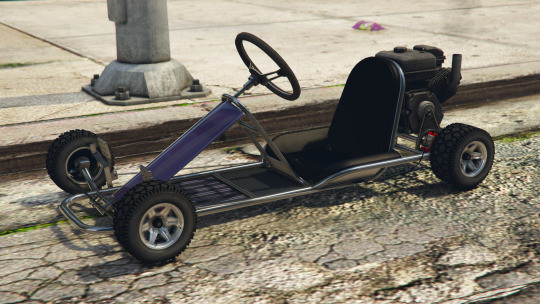
The Veto Classic was given out for free as part of a promotion when the GTA community completed a challenge for heisting the most money collectively over a couple of weeks. I didn't drive mine much, but we all had a good laugh seeing one of our buddies dress up in a Mario costume and drive the thing around.

Curiously, the regular Speedo was one of those old vehicles that could be insured but not painted or modded. This one has had that limitation circumvented through the use of the poorly programmed yet official iFruit app.
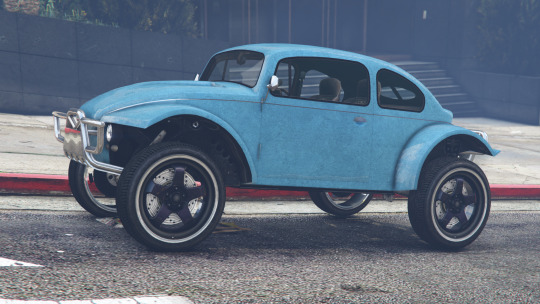
Back before the Weevil was added to the game, the only way to get something resembling a standard Beetle was to glitch regular wheels onto an Injection like this. Using iFruit limited you to the Sports category, which is what was used here, whereas a full-featured merge glitch granted access to the whole catalog.

Remember the FIB Buffalo from GTA IV? This was my attempt to recreate that, from back before we got the newer wheel categories with better steelies in them. The Buffalo used to have a glitch to remove the skirts from it, as shown here, before eventually getting patched years later.
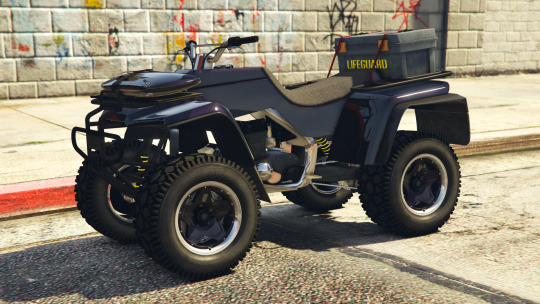
The Blazer Lifeguard was considered a flex vehicle for many years. It was a rare spawn that could be stored in garages, but not modified or insured without the use of very rare glitches, so having one like this and driving it in the wildlands that were public lobbies was a rare occurrence. Eventually it was added to the shop for purchase and it became little but a pleasant memory.
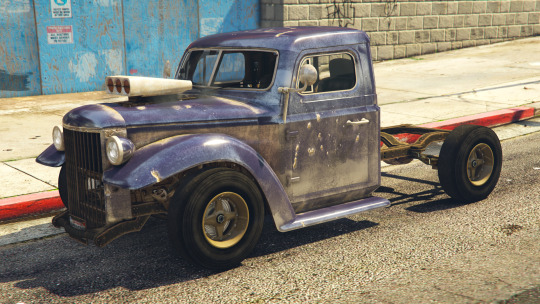
The bedless Rat-Loader was another classic meme vehicle. By switching certain between mod options on certain vehicles, it was possible to "trick" the game into having none equipped at all, and this was an example of that. What made it even funnier was that the truck then lacked collision boxes on its rear end, allowing two of them to be reversed into each other to create a CatDog abomination.

Having a Romero Hearse in the olden days meant you had friends. It was a vehicle that only spawned in missions, or if someone who already owned one used theirs to spawn a wild one for you. This one in particular was even more unique, as it had been glitched to have the casket and rosary removed. For the longest time, it was my white whale, hence the license plate.

Driving the Faction was an interesting experience. The stock model, which hadn't been upgraded into either of the two Benny's variants, had bugged collision boxes which caused it to crash and flip wildly whenever it hit a curb or other low obstacle. It was frustrating, to say the least, but it also caused you to see the game's map in a new light and drive more realistically, since it's often all too easy to ignore curbs in GTA games. In addition, this particular Faction had an unobtainable modification in the form of the power bulge on its hood.
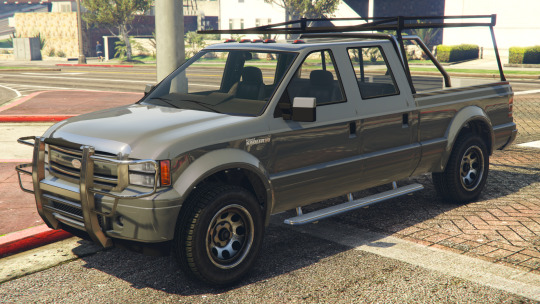
This famous workhorse was vital when it came to obscure vehicle mods. The Sadler had many visible "extras" in the form of its accessories, which corresponded to various parts of other vehicles that were unmodifiable at mod shops, making it incredibly useful for merging with vehicles such as the Faction above or other vehicles with unwanted interior clutter. On top of all that, it was also just a really nice truck.
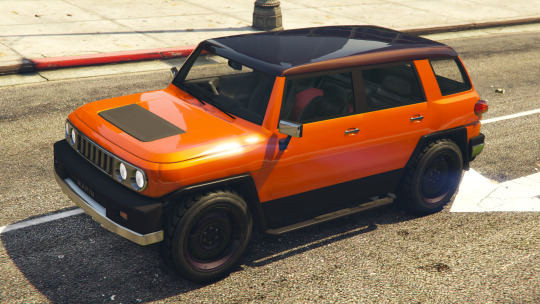
The BeeJay XL was the vehicle I always brought to Halloween festivities, because of the covered body in the back seat. This feature was used in the single-player campaign during the mission where Michael hides in the back seat of his car to catch Franklin, but it could also be obtained through glitches when playing online.
1 note
·
View note
Note
You've probably written about that but let's get into some details: what inspired Meow's design? From the species of awakened kitty, to the parts of their outfit, the spells they slot, the name? (The name I do recall you explaining so no need to answer that one, just in case people dunno and want a link or something.)
Bonus: list your favourite feline characters in media.
Meow started out as a friend's character concept that never got used: a wizard polymorphed into a cat who kept her (I think it was a her...) spellbook as scratch marks on a board somewhere in a house (like, attic floorboard sort of thing). The form was intentional for some reason; I don't recall if she was a nothlit or not, but I'm pretty sure given the friend that she wasn't.
Meow's transition into my character concept (before becoming a sorcerer) started with the "cat wizard" premise and nixed the polymorphy part. (I like making inhuman characters.) I chose Jiji (Kiki's Delivery Service) as the general model because I've always liked him. The bit about being kitten sized but fully grown is mostly that Jiji looks really small to me relative to the humans, though his girlfriend is about the same size. (Other Ghibli cats are larger.)
I then added a wizard hat -- probably inspired by that image I found, but mainly to be on-the-nose about it.
So there's Meow at basics: Jiji with a wizard hat.
The trouble with playing a true cat is that, with D&D's rules as written, you can't cast spells and can barely use magic items: D&D requires human speech for verbal components for spells and command words for many magic items (incantations) and human-like hands for somatic components (gestures) for spells and holding or using most magic items. Animals don't even necessarily get the same magic item slots in editions that use such a system! So what's a cat caster to do?
This is where ioun stones and reserve feats (mentioned in Meow's bio) come in.
Ioun stones are slotless magic items (so you don't have to worry about whether or not you can equip them) that provide passive bonuses to whomever they're equipped to. They're slotless because they float around you -- no need to interact with them with hands, don't have to wear them. The only trouble I have with ioun stones (and the reason I have yet to use them in a game) is that since they are little gems (of any gem shape) orbiting their user, someone else could (and would) simply snatch them away. (I think this is a little too easy and they should get some sort of telekinetic resistance to such attempts while equipped, but that's just me.) Prior to use on this blog, Meow would have taken all of the feats and prestige classes needed to reduce the number of pages it takes to transcribe a spell into a spellbook, then would have engraved the spellbook onto ioun stones (one spell per stone). This would give Meow a spellbook a cat could carry.
(I had also considered Spell Mastery, but that's so limited that you may as well be a Sorcerer.)
Reserve feats were late additions to 3.5, appearing in Complete Mage and Complete Champion. Each feat gives you an ability similar to a 5e cantrip in power, but (frequently) equivalent in theme to a low-level spell: so long as you have a spell of an appropriate type (usually a subschool or descriptor) "available to cast" (meaning you have a spell slot available that can cast a given spell of the type specified and either you know such a spell [Sorcerer] or have it prepared [Wizard]), you can use the feat's granted ability at-will. Usually, the ability's save DC, damage dice, range, and/or duration scale with the level of the spell held in reserve. These abilities are Supernatural, which means they don't use components at all, take a standard action (= 5e's action) to use by default, and do not provoke attacks of opportunity, but are negated in antimagic fields and do not benefit from most feats and class features that improve spells. There aren't many good ones, sadly, and there are few ways of "optimizing" such feats, but they're helpful in an edition that didn't even have at-will cantrips.
With those things and the Silent and Still Metamagic feats (yes, metamagic was a category of feat in 3.5), Meow would be functional, if low-powered for a Wizard.
These were all hypotheticals until I got the appointment to the Collective. Meow had been on my mind at the time, but had been sitting in murky half-thoughts for a while before then, so it was more happy coincidence that I ended up changing Meow from a wizard into a sorcerer. (I was tempted not to: it almost defeats the purpose of the ioun stones.) That and I'm sick of playing humanoids besides elves, but that's a digression.
I had most of what I needed, but was left with a name. Dissatisfied with options I found on random name generators, I decided to make my own. I combined "Ozymandias" with "Meow" and changed the initial vowel; I then inserted "Felix" in there and pretended the resulting "-xas" was enough to evoke "Abraxas". "-imilian" at the end is because I think "Maximilian" (or however it's spelled) is fun to say. I don't recall where the "-cyrri-" came from off-hand; I know I wrote it down somewhere. (It might be to add letters of the alphabet.) "But no one will get the allusions if stacked that much!" Quiet, you! The point was to come up with an outlandish name -- the sort you see fictional wizards using. The longer the name and the harder it is to understand, the more difficult it is for someone to steal it. Plus, it makes "Meow" funnier. ("Chiro" is a common Japanese cat name; I list it as an alternative because even I think "Meow" is a dumb name for a cat.)
Favorite fictional cats: Jiji, Mewtwo, Mew, Meowth/Persian, maybe Salem (Sabrina the Teenage Witch), ... I'm sure there are others. I like cats, I just don't tend to think about them re: favorite characters.
And, as always, glompage for the ask!
15 notes
·
View notes
Text
Dragon Quest V: Baby Dungeons
Circe here! I've only just started Dragon Quest V, but I've been thinking, given the sheer size of my last post on Dragon Warrior IV, maybe I should be writing shorter, more frequent posts rather than letting a huge amount of plot build up before posting, especially now that the games...actually...have plot. Besides, there's a lot to talk about right off the bat. First thing I should cover is that the SNES version of Dragon Quest V has never been localized to English. Dragon Quests IV through VI eventually got DS remakes that were released in the US, but I'm sticking with the original version of every game, so that means either rolling with a Japanese version or finding a fan translation. I know I talked a big game about playing untranslated games earlier, but these games have gotten a lot more text-heavy in the interrim, so that would probably slow things down a lot. I'm still not ruling out the possibility for future games, but for now, I think this works fine. This does mean that there may be localization choices that aren't consistent with any official localization, so this may be quite interesting, we'll see.
As for the game itself, as you might expect from an early SNES RPG, it's a weird mix of graphical and mechanical improvements paired with weird holdovers from the NES era. I was really hoping that the DOOR/TALK/SEARCH menu items would finally go away, but no, it's still here, and it looks even weirder next to the considerably better SNES graphics. However, with the extra buttons, they've added another button that appears to be a context-sensitive shortcut, so I may be leaning on that a lot instead. Menu navigation on the whole is pretty similar, although our characters have a bigger inventory, and equipment purchasing is even further improved by showing how each item in the shop will change each character's stats. I can't say it's not improved, but we're not really at the point of 'hey, this is a modern RPG now' quite yet. And that's...very weird, actually, because Final Fantasy IV was released the year before this game, and despite also having some weird NES holdovers, the UI is better in almost every way (except purchasing equipment, actually, I have to give DQ5 credit there). In fact, I don't know if Final Fantasy has *ever* had anything like Dragon Quest's clunky menu-driven interaction system, so it's very weird that it's lasted, in some form, for five games. But it's not like I haven't acclimated to it by now, so it's not a big deal.
So what is Dragon Quest V about? Well, it opens with our hero's birth. We see our papa...named Papas...and our mother, whose name I forget, celebrating the baby's birth and fretting over a name. As you might guess, they just happen to settle on a name I picked (Papas initially complains that it sounds 'too feminine', which is weirdly on the nose) and then the mother dies. So, uh...well that's kind of a downer to open on. In any case, our gender is fixed in this game (male, as you might guess) but I can't complain too much, since this one is probably going to be even plot-heavier than in the past. I think our character even talks. But it's a good thing, then, that SEN is a gender-ambiguous name. And no, I'm never going to stop using allcaps.
So, skip ahead to when SEN is a young adult...haha, just kidding, you're six. Apparently, Papas is a bit of a wanderer, but we're on a boat just about to make port in his hometown of Santa Rosa. Here on the ship we're going to get acquainted with one of the big changes in Dragon Quest V. At least here in the early game, you're pretty hemmed in, and the game expects you to talk to NPCs in the area in order to advance the plot. A far cry from the wide-open world of Dragon Warrior, but it's little surprise, since each game up to this point has taken little steps in this direction. And our character is, after all, six. Once we reach the dock, Papas immediately busies himself talking to some guy, so of course we wander off and immediately get into an encounter with some slimes. After a couple turns of feeble swings at the monsters, Papas steps in to protect us, taking out the slimes easily with blows upwards of 70 damage. So okay, he's pretty tough. He heals us, and we walk the short distance from the dock to Santa Rosa. This is a scripted sequence where Papas leads the way, but there are still random encounters like normal (okay, they're probably scripted, but it gives the appearance of random encounters). Papas handles the monsters with ease, and we head into town.
Here Papas bumps into the wife of his friend who runs an inn in the nearby town of Alcapa. Apparently, he has fallen ill, and his wife came here to get medicine. And we meet her daughter Bianca, who quickly gets bored of listening to the adults talk, and goes upstairs with us to pass the time. Being two years older, she's able to read, a little, so she takes out a book to read to us. It doesn't take her long to give up, though, complaining that the words are too difficult. It's not long before Bianca's mother comes to pick her up, and then it's just us and Papas again.
Papas seems to be a bit of an inattentive father, to be honest. He's busy with grown-up stuff, and we're left to our own devices. You can wander around town and talk to people, and find out that a man who went to find the medicine has gone into the nearby cave and hasn't come out, or you can, like me, just find the cave and decide this is an excellent idea without finding out why you should go there. There's a guard keeping six year old children from wandering out of town, but the cave is unguarded -- well, no, that's not true, there is a guard by the cave entrance, but he merely warns you that going into the cave is a bad idea and it's not his fault if you get lost. I know we're an RPG hero, but I want you to consider for a moment that by all reasonable standards, this adult human just stands there and watches as a literal six year old wanders to his likely death. Oh well. It would've been inconvenient if he'd stopped us. Don't let the fact that we're six years old give you the idea that we won't be fighting slimes, bats, and moles, or buying weapons and armor at the local shops. It's much funnier to instead picture our hero beating monsters to death with a stick using his tiny baby arms.
At the bottom of the dungeon we find the man trapped under the rock, and give him a hand. So, uh, probably good that someone came down here eventually. That done, Bianca and her mother are ready to return to Alcapa. Papas doesn't like the idea of them traveling on their own, though, so the four of us set out together. Once the medicine is delivered, Papas seems anxious to leave, but it seems that Papas's friends wants him to stay awhile and he, relucantly, agreed. I get the impression that Papas is concerned with...something. Something that's keeping him from his family and friends. But it's too early to say what it is, really. I'll admit, it reminds me of my time playing Taloon in Dragon Warrior IV, getting up in the morning and leaving his family every day to go stab monsters, except this time I'm the child instead. Did Taloon's kid understand why he left for so long, or why they eventually uprooted their lives to move to the much bigger and busier city of Endor? There's no telling, I suppose.
Alcapa is pretty similar to Santa Rosa, although it has a nicer shop and no dangerous open cave for children to wander into. Here, we spend more time with Bianca, and if we chat around a bit, we find a couple more kids tormenting a cat, presumably for no other reason than that they're assholes with nothing better to do. We try to intervene, and they tell us they'll let the cat go if we go fight ghosts in the haunted castle to the north. Okay. This seems a little artificial, especially since, if we're strong enough to do that, we're strong enough to deal with these little shits, but the quest is clear, so that's what we gotta do. We can only leave town at night when the guard is asleep, but that's no big deal, since the shops and everything are still open.
Bianca starts out at level 1 with pretty pitiful equipment, so the first thing I do is grind -- mostly for gold, but I get some decent levels in the process. This game introduces an interesting new feature -- weapons that can hit multiple enemies. I get a boomerang for myself, which can hit every enemy, and a thorn whip for Bianca, which can hit a single enemy group. The downside is that they do less damage to each consecutive enemy, but it's still a huge benefit, reducing large enemy groups to nothing in one or two strikes.
With that done, we head north to Lenoire Castle. I think one purpose of this dungeon is to show off a lot of the new event scripting stuff, kinda like Taloon's chapter in Dragon Warrior IV. This place is pretty damn haunted, with object moving around, doors opening on their own, and, uh, also there's ghosts everywhere trying to kill us. That's, I guess, the biggest hint probably. But it's also clear that they wanted to show off what this new engine can do. Along the way, we meet the ghosts of the former king and queen of the castle, who are apparently being hassled by bad ghosts. Eventually we meet the boss of the bad ghosts, called...Boss Ghost...and he's pretty tough. Bianca drops in this fight, which kinda sucks, but I get through it. Oh, and offensive spells and attacks are finally animated, which is a touch that has been sorely missing until now (our characters don't appear on-screen, so naturally, anything that targets them is not animated). With that done, the good ghosts are at peace, and we get...oh no. A Gold Orb. I mean, okay, we don't know what it's for yet, but I'm wary of generic macguffins at this point.
We hang onto the orb and head back to Alcapa. The shitty kids let us have the cat, and it joins our party...uh, apparently it's a baby panther, which raises a lot of questions about why it's tame and in town. But whatever. Bianca names it Borongo. I think we can rename it if we want, but I decide not to. Papas leads us back home, and we leave Bianca behind, but Borongo sticks with us. Back in Santa Rosa, there doesn't seem to be much going on at first. A lot of townsfolk are complaining about random little objects going missing, which sounds significant. Eventually, if we poke around, we see what appears to be a ghost. The ghost is surprised we can see her, and she says she's been messing with people in order to try and get their attention. Apparently she's really an elf, visiting the human world through some kind of, spirit projection I guess? She leads us to the basement of our home where nobody else is around, and says that the world of elves needs help, and we need to go there right away. Um...so everything I know about fantasy tells me that when an elf tells a very small child to go to their world with them, it's a pretty bad idea. But this isn't really that sort of story, and we don't really have a choice, so off we go.
In the world of elves, we're told that a magical flute has been stolen, and we need to get it back, because they need it to change the seasons, so the human world will fall into eternal winter without it. That sounds pretty bad. The elves have a lot of confidence that a six year old child and his cat can fix this problem, but to be fair, we've got a surprisingly good track record up to this point.
Well, that's all for now. I guess I was right to start writing a new post now, because this turned out to be pretty long anyway. I guess these posts might end up getting a lot more frequent to keep up with the plot, so stay tuned!
2 notes
·
View notes
Text
Pit People Review - Another Hit From Behemoth
With hilarious dialogue, addicting gameplay, and hundreds of creative quests, Pit People is most certainly a success, living up to the standards set by Castle Crashers and BattleBlock Theatre.
Pit People is the latest release from indie developer Behemoth, tackling the strategy genre with their signature style. The company’s move from a 2.5D action game to a side-scrolling puzzle game to a top down strategy game shows they are willing to try new things with every release.
Story & Characters
In Pit People, players take control of Horatio, a man seeking to get his child back from a giant space bear. Horatio travels around the world fighting, looting, and capturing enemies in an attempt to strengthen his squad and save his son. The base story isn’t all that important, but the dialogue and situations that unfold are incredibly charming.
Once again, Will Stamper shines as the narrator in another Behemoth game, and is as hilarious as he was in BattleBlock Theatre. The bizarre conversations between him and the characters are hysterical, especially the way regular folk speak gibberish. It’s amusing to see the narrator do something awful to Horatio and then witness Horatio angrily respond with a string of made up words. This is even funnier considering that there is occasional coherency in these words, as certain things don’t sound like gibberish and sound slightly similar to English.
There are also a lot of small jokes in the world, characters, and dialogue. The game is mostly successful at making jokes anywhere it can, but it occasionally falters. The common poop jokes for instance were never very amusing.
Gameplay
Players travel around a modestly sized overworld and take bizarre quests from bizarre individuals. Either that or you can accept the story missions back at the hub and go along with the main content. No matter which route you go, these quests are incredibly creative, fun, and engaging. The most intriguing aspect of the game is that even the side missions feel as thought out as the main ones. The story quests do have a bit more style, but the alternative ones are just as well made.
When it comes to the actual combat, the player commands their characters to move to specific spots on the map. If they’re next to multiple enemies, they will randomly decide who they’re attacking.
For example, if you move Horatio to a spot where four enemies surround him, he will randomly choose which one to attack. This can be problematic, but it adds a layer of strategy because it forces you to move to spots where your character won’t be surrounded, allowing them to focus on a single individual at a time. This is also the case with bows and cannons, as it’ll randomly select people to shoot within range. Thankfully, the range on these characters is so unpredictable that you can usually move them into certain spots to target specific enemies.
Thankfully, the game gets even better with a friend. Certain titles only allow you to play portions with someone else, but all of Pit People is accessible with a friend. Not only that, but it’s balanced well for co-op. The game doesn’t get too easy or too hard during multiplayer, which mainly has to do with the level design. Sometimes, players focus on specific tasks that have them on different sides of the screen. Other times, both will be work together to take down a fearsome boss.
Customization & Leveling
When a battle is over, the player earns gold, armor, and weapons. This is where the game allows a lot of personal choice in how you build your character, as certain weapons have wildly different effects. For example, I’m personally addicted to an ice mortar that freezes enemies from a long range. It’s very different from any of the other ranged weapons, and possesses high utility for intense battles.
This customization system works incredibly well, especially when you add the many different enemies you can capture. Towards the end of a battle, you can capture the final enemy and put them in your squad. From pixies to spidaurs and giant cyclopes, any new member changes how the game plays entirely.
Putting a swordsman with high damage output on top of a spidaur with high defense creates a destructive nightmare. You can go even further with these additions by adding swift kobolds, regenerating zombies, unicorn snipers and more. The character customization and team member diversity creates a dynamic that makes Pit People feel fresh from the slightest change.
However, the big problem is that there’s not much incentive to keep any of your characters. Even if you get attached to a specific character, there aren’t any skill points or unlockable abilities to make characters feel unique. Everything about each character is too broad, as the customization solely relies on equipment anyone can equip, and this is even worse considering there’s a level up system.
This level system provides slight bonuses but doesn’t matter as much as it could. It would’ve been great to be able to choose how to build character’s stats or customize minor abilities. Having the game choose where those stat bonuses go isn’t any fun. Even then, leveling up is a great lifesaver in combat. If a team member is about to die, they can instantly heal to max HP upon reaching a new level. This mechanic saved many lives throughout my playthrough.
Overworld, Marquette, & Misc.
Unfortunately, the overworld is annoying to travel through. The obnoxious gas always blocks your view, making it genuinely uncomfortable to see. The world is also gridded, which seems visually contradicted by the smooth animations of the moving cart and walking enemies. It also makes shooting awkward when you’re auto-locked to a certain grid point and the enemy is moving normally throughout the grid. Additionally, the coins that you can find on your travels feel pointless, as they don’t provide enough incentive to collect.
When it comes to the Marquette, there’s not much there. You can purchase new party members for a large sum of money—which is not worth it—and you can buy a randomly assigned item on display. Aside from that, there’s the shop which allows you to only purchase practical items like a revive potion and a campfire, which heals all party members in the overworld.
Overall, the currency system could have a lot more to it. The only reasonable thing to purchase are these practical items which are dirt cheap, almost always causing the player to have a lot more money than they should. Similar to the level up issue, it would be interesting if additional abilities or special skins could be purchased. Pit People simply needs an additional incentive to spend money.
Throughout my first three hours or so, I used a keyboard and mouse to play. However, this became extremely obnoxious considering some of the controls. It was difficult to precisely select characters with a mouse wheel, as it would often go to the incorrect one. Not only that, but moving the cart felt robotic and hard to control. These are small issues, but it was enough to make me switch to a controller.
As the name suggests, you can also fight in The Pit. This is a combat oriented arena where you can battle other players or take on a tournament against NPCs. Fighting other players is a ton of fun, and going through the tournament provides many rewards for the victors. Even then, it’s pretty strange that The Pit isn’t as significant as the game title would suggest. It’s not a problem, just interesting to think about.
Visuals & Sound
Pit People takes on a classic Behemoth visual style with goofy humor embedded in its art and silly designs for its characters and world. This works very well for the most part, as certain hats and weapons are genuinely hilarious.
There’s nothing more amusing than using a trash can as a shield, throwing letter blocks at enemies, and attacking people with a stick of meat. The player can also travel to a giant toilet town, adopt a poop mascot, and give their cupcake medic a soldier’s cap. There’s nothing serious about the way the title is designed, and it’s a relief.
When it comes to its soundtrack, Behemoth impresses again with more bizarrely styled tracks. Some of the music seems genuinely experimental, using random sounds to put together a piece. Even with these tracks, the songs themselves sound great, creating intense, hilarious, or weird atmospheres when appropriate.
Verdict
Pit People is amusing, addicting, and an absolute blast to play. It’s a strategy game full of content, with the studio’s twisted humor embedded in everything. Thanks to incredibly diverse quests, hundreds of customizable options, and incredibly funny dialogue, Pit People is another hit from Behemoth.
span { display: block; } h2 { text-align: center; } h2 { border-top-style: solid; border-right-style: solid; border-bottom-style: solid; border-left-style: solid; }
Score
table, th, td { table-layout: fixed; border: 3px solid #6698cb; border-collapse: collapse; text-align: center; color: #545454; }
Good Bad Hilarious Dialogue Annoying Overworld Creative Quests Bland Leveling System Fun Capture System Keyboard and Mouse All Content Accessible With a Friend Underdeveloped Marquette Addicting Gameplay Great Soundtrack Quirky Visuals
h1 { text-align: center; color: #5a5a5a; }
- 8/10 -
1 note
·
View note